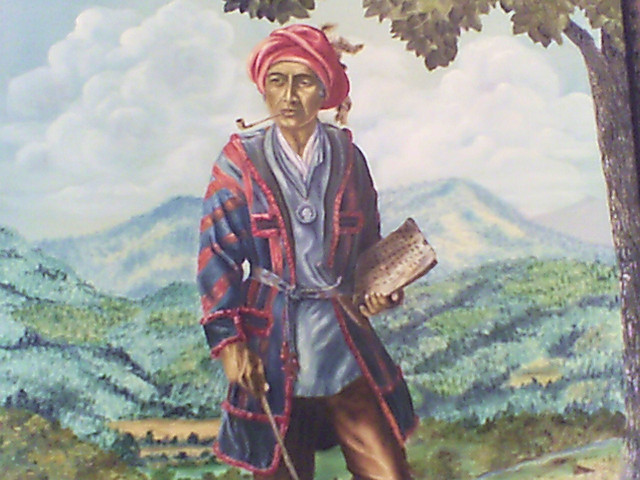Sequoyah: The Founder of the Cherokee Written Language

Sequoyah
The Cherokee written language was constructed by a man named George Gist. Being half-blooded Cherokee, George was also known as Sequoyah, which in Cherokee means “Pig’s Feet.” From oral tradition we know that he was called this because of a limp he received as a result of a hunting injury.Sequoyah’s father was Nathaniel Gist, a fur trader in Virginia and a dear friend of President George Washington, who he fought alongside with in the American Revolution. Nathaniel’s main role in the war was convincing the Cherokee not to side with the British. After the war, Nathaniel married a young lady of the Paint Clan named Wut-eh. In 1776, she gave birth to George – or, as we know him, Sequoyah.
As Sequoyah grew up in the foothills of Virginia and in the Smoky Mountains of Tennessee, he was exposed to the English language but never became literate. Later on, he moved to Alabama and joined the United States Army for only 60 days, fighting in the Battle of Horseshoe Bend under the command of General Andrew Jackson in the War of 1812. Here, the Cherokee regiment helped defeat the British led Creek Red Sticks. Over the course of those 60 days, Sequoyah and his Cherokee friends grew frustrated with having to miss out on some of the benefits the white soldiers had, including writing letters to home and being able to read military orders.
Settling into the Cherokee way of life, Sequoyah found himself dealing in fur trading, silversmithing, and blacksmithing. Cash was the primary currency of the day, and if no cash was available, farm goods provided an adequate substitute. In instances where customers could not pay Sequoyah, he would have to remember it somehow. Being illiterate, he devised a system of drawing a portrait of what the person looked like and what work he performed for them.
This personal style of hieroglyphics worked for Sequoyah, and these drawings would later resulted in him creating his own numbering system which covered numbers 1-20. After reaching the number 20, the system jumped by tens and then hundreds. The numbering system became an even better source of keeping tabs on who owed what. By creating this numbering system, Sequoyah came to the conclusion that if a made-up numbering system worked for him, he could also create a much-needed writing system for the Cherokee.
The spoken Cherokee language consisted of a combination of common sounds. Sequoyah quickly recognized this and began grouping sounds together and giving each one a symbol. The end result of his efforts were 86 common sounds, each having its own symbol. Putting the symbols together, they formed words and phrases. This system allowed the Cherokee language to be transferred from speech onto paper. Sequoyah stopped here, though, only developing a syllabary. He did not break the language down further into an alphabet.
Tribesmen began to wonder about Sequoyah. They began to think he was up to some form of witchcraft. He would always be outside in the shed for hours, making strange markings on paper, which they thought were curses or spells. Being brought before the Chief and Council in 1821, Sequoyah explained what he was doing.
He told the tribesmen about how now they could possess a written language and how it would help them to communicate amongst other tribes, as well as with other people in the United States. To test this written language, Sequoyah wrote down everything the chief said. After this, he gave the paper with the writing on it to his daughter, who was not with him during the meeting. She was able to read back everything, word for word, of what the chief had said earlier. Upon noticing this, the Cherokee accepted the writing system and began using it. All Cherokee had adopted it by 1825.
With the Cherokee writing now made available, there became a need for teachers, writers, and a delivery system of letters, creating a new economy within the Cherokee Nation. Printing presses were ordered and were made with the Cherokee symbols. In order to save money, the Cherokee revised and altered the symbols to look more like the English Alphabet, making the written Cherokee language look a little like a mixed form of English.
With the printing presses made available, the Cherokee were able to print a bi-lingual newspaper called The Phoenix. Evangelical churches and missionaries soon took advantage, printing Bibles in the Cherokee Language. In a short time, the Cherokee Nation became a literate people, able to keep up with local and world news.
In New Echota, Georgia, at the National Council of the Cherokee Nation, Sequoyah was awarded a silver medal in 1824. By creating a written language, all the tribes were now united, and the Cherokee could now communicate with the western world. Sequoyah, a half- blooded Cherokee who was illiterate, had envisioned a written Cherokee language and had created it. For the first time in modern history, a language was created all to its own, with no help from outsiders.
To find out more about Sequoyah and the Cherokee written language, visit the Sequoyah Birthplace Museum located in Vonore, Tennessee.
